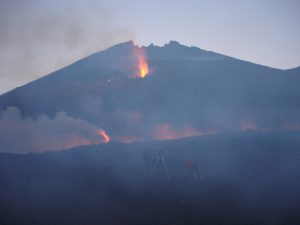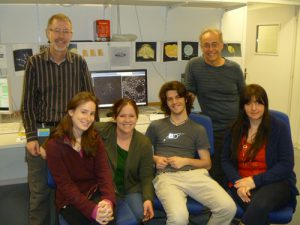
By Jim Hynes
While scientists don’t yet fully understand the mechanisms that control whether a volcanic eruption is large or small, they do know that eruptions are driven by the rapid expansion of bubbles formed from water and other volatile substances trapped in molten rock as it rises beneath a volcano.
“Volcanoes erupt basically like shaking up a bottle of carbonated drink and opening it up,” says Prof. Don R. Baker of McGill University’s Department of Earth and Planetary Sciences. “It’s not that much different in terms of its fundamental aspects. It’s the details, like most science now. We understand the basic ideas but the details are critical. And finding the details requires a lot of little studies like this.”
The “little study” in question was conducted by Baker and his colleagues on an international research team. Their findings, recently published in Nature Communications, represent a small but important step toward the goal of being able to predict the type of eruption that will occur in various volcanic regions of the world. The study suggests the difference between a small or large eruption depends on the first 10 seconds of bubble growth in molten rocks. And its findings point to a need to develop volcanic monitoring systems that can measure rapid changes in gas flux and composition during those brief, crucial moments.
“Basically all we’re trying to do is understand better what drives volcanic eruptions with the hope of being able to, in the long term, maybe better predict them or at least say something more about the activity,” Baker says.
Baker and his colleagues examined the growth of volcanic bubbles in real time by heating water-bearing molten rock with a recently developed laser heating system at the Swiss Light Source facility in Villigen, Switzerland, where they could perform three-dimensional X-ray microtomography (CAT scans) of the samples during the first 18 seconds of bubble growth and foaming. With these images, they were able to measure the number and size of bubbles, investigate the geometry of the connections between bubbles, and calculate how quickly gas flowed out of the sample and how the foam strength dropped.
The team found that initially thousands of small bubbles per cubic centimetre formed, trapping gas inside them, but that they swiftly coalesced into a foam of larger bubbles whose strength rapidly decreased while the rate of gas loss increased. All of these changes occurred within the first 15 seconds of bubble growth. They then determined which conditions of bubble formation and growth lead to failure in the rock.

Baker, a professor at McGill since 1990, has been working on characterizing natural magma samples and how explosive they are since 2003.
“Basically how we characterize them is by the size distribution of the bubbles—are the bubbles all the same size? Do we have a wide range of sizes? Is it a nice sort of classical statistical shape or is it shifted? By studying samples we’ve found that there seems to be a link between the size distribution of the bubbles and the eruptive behaviour. So, working on that we can start to say something. We need to test it more, but we have some hints that we can say something about the type of volcanic activity that can be expected.”
Baker says a number of different factors can be can cause bubbles in magma to expand at different rates.
“That’s part of the details we’re still working on. Sometimes you have magma mixing – sitting in the magma chamber below a volcano you have a cooler magma, and then another hot magma intrudes inside. The hot magma cools, and as it does the bubbles start to grow rapidly.
“Another thing that can happen is what occurred at Mount St. Helen’s in 1980. There was a landslide and the top of the volcano started to slide off – exactly like opening up the top of the bottle, you release that pressure. Any mechanism that releases the pressure causes the bubbles to grow. If it’s a slow release the bubbles should grow slowly and if it’s a rapid release the bubbles should grow quickly. We were surprised at how quickly the bubbles grew in our sample.”
Co-authors of the study are Francesco Brun, of Universita’ degli Studi di Trieste in Italy; Lucia Mancini of Elettra – Sincrotrone Trieste; Cedrick O’Shaughnessy, a former McGill master’s student; Julie L. Fife of the Swiss Light Source at the Paul Scherrer Institut; and Mark Rivers of the University of Chicago. Funding for the study was provided by the Natural Sciences and Engineering Research Council of Canada and the Swiss Light Source.
With files from Chris Chipello
